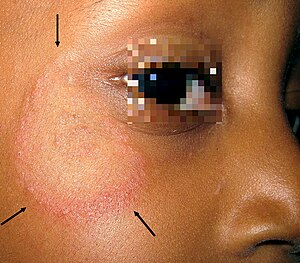Tinea faciei
| Tinea faciei | |
|---|---|
| Other names | Ringworm of the face |
 | |
| Tinea faciei | |
| Specialty | Dermatology |
| Symptoms | Facial ringworm appears as one or more pink-to-red scaly patches which contain bumps, blisters, or scabs.They can be itchy, and it may get worse or feel sunburned after exposure to the sun. |
| Treatment | topical creams and lotions: Terbinafine, Clotrimazole, Miconazole, Econazole, Oxiconazole, Ketoconazole, Sulconazole, Naftifine |
Tinea faciei is a fungal infection of the skin of the face.[1] It generally appears as a photosensitive painless red rash with small bumps and a raised edge appearing to grow outwards, usually over eyebrows or one side of the face.[1] It may feel wet or have some crusting, and overlying hairs may fall out easily.[2] There may be a mild itch.[3]
Treatment[]
Most infections can be treated with topical antifungal medication. Rarely, more extensive or long-standing infections may require treatment with oral antifungals. The infection will still be contagious between 24-48 hours of the first treatment.
The ringworm should go away within 4–6 weeks after using effective treatment.
This section needs expansion. You can help by . (February 2019) |
See also[]
- Tinea corporis
- Antifungal drug
- List of cutaneous conditions
References[]
- ^ Jump up to: a b James, William D.; Elston, Dirk; Treat, James R.; Rosenbach, Misha A.; Neuhaus, Isaac (2020). "15. Diseases resulting from fungi and yeasts". Andrews' Diseases of the Skin: Clinical Dermatology (13th ed.). Edinburgh: Elsevier. p. 295. ISBN 978-0-323-54753-6.
- ^ "Tinea faciei (face) and barbae (beard)". www.pcds.org.uk. Retrieved 18 September 2021.
- ^ Ginter-Hanselmayer, Gabriele; Nenoff, Pietro (2018). Presterl, Elisabeth (ed.). Clinically Relevant Mycoses: A Practical Approach. Springer. pp. 149–150. ISBN 978-3-319-92300-0.
External links[]
| Classification |
|---|
Categories:
- Animal fungal diseases
- Mycosis-related cutaneous conditions
- Infection-related cutaneous condition stubs